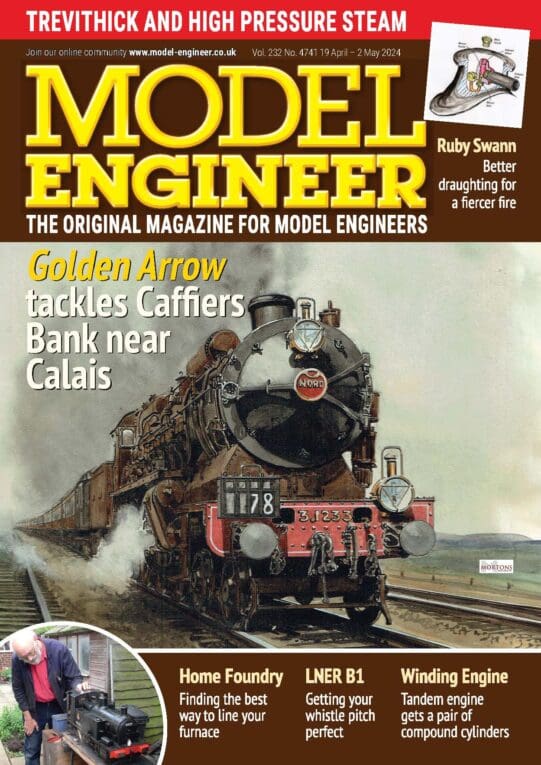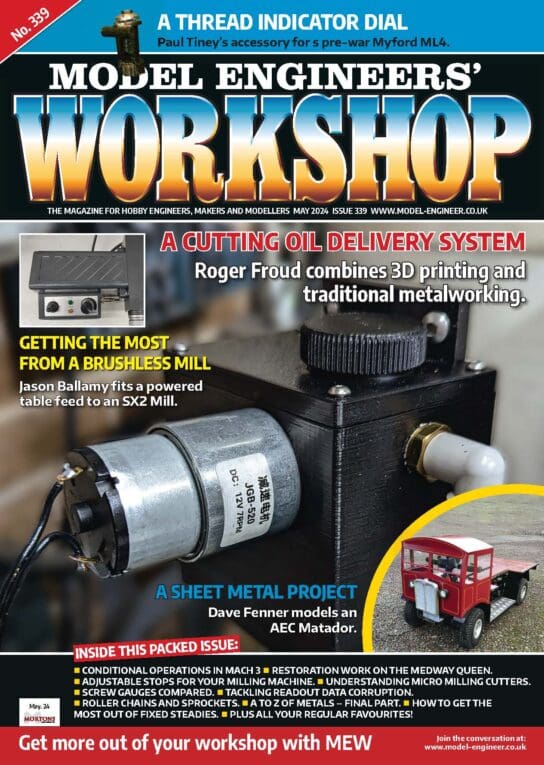It was a nice fine sunny day as I set out for the Guildford Model Engineering Exhibition on Saturday 21st July 2007. The weather forecast was showers and I had heard the Guildford club tended to get water logged.
I reached Guildford, found the correct road and went along it then realised I was on the right road, going the wrong way. A quick U-turn and I soon found Stoke Park. I was one of the early birds and although it was advertised as an 11 AM start, the public were allowed in very early. Parking was easy and well organized and also mud free. I walked over to the kiosk and paid my £6, (no, I dont expect to get in for free) and went through to the main exhibit tent. There was a very large quantity of high-class exhibits on display. There were several interesting tools on show. John Carter made his coaxial centering gauge from a design in MEW, photo 1. The fitted box is a nice finishing touch.
Enjoy more Model Engineer reading in the monthly magazine.
Click here to subscribe & save.
John also exhibited a precision tool grinding rest for grinding screw-cutting tools on the correct angle and for grinding form tools etc., photo 2.
The height of the tool rest is set by means of an under rest knurled screw. A locking screw holds the table at the correct height. The diamond tool dresser slides in the traverse slots in the rest after sliding the rest away from the wheel. A fine feed screw controls the feed.
Clive Lawrence is constructing this wheel-cutting engine, which is made to a design by Elliot Isaacs FBHI and described in The Clockmaker volumes one and two, photo 3.
Some press tools were on display, photo 4. The right hand press tools are to produce the cleading on the front rounded edge and corner of the firebox on a 3.5in. gauge GWR Firefly locomotive. The left hand tool produces the covers on the smoke box. The tools were made by Bernard Hatcher.
A centering microscope and its fitted box were displayed by Clive Lawrence, photo 5.
Tony Rest made the gauge 1 Great Northern Atlantic Henry Oakley, photo 6 and the Great Northern coaches, photo 7.


The 16mm scale First World War protected Simplex and three slate wagons, photo 8 were made by Frank Welland. A lot of model engineering clubs now have 32mm narrow gauge tracks. 16mm Narrow gauge is the ideal scale if you dont have the time or finances to build a 3.5in. gauge or larger engine. It is also a very good scale to have a garden layout in.The Indian style coaches and the scratch built guards van in the background of photo 8 are by Ken Hadingham, again to 16mm scale. See also photo 9 for a close up of the guards van.
A 16mm scale freelance crane, photo 10 and 11 and support vehicles were shown by Roger Haywood.
A half scale 1938 works 350 Velocette motorcycle engine, photo 12 a half size Matchless G45 racing engine, photo 13 and a half size G50 Matchless racing engine, photo 14 were all built by Bill Connor.
John Carter made the fine collection of model engines seen in photo 15. Left to right, back to front, they are Stentor, a 6cc two stroke, Atom Minor, a 6cc two stroke, JCEF, a 0.5cc two stroke, Edgar Westburys 10cc Seagull, Midge a 0.8cc diesel engine, a half size Mills 1.3cc single two stroke, Robin a 1.5cc four stroke, Battiwalagh a 1.5cc two stroke and finally JCJCEE which is a 0.5cc two stroke to Johns own design.
Norman Lawrence built this 24 cylinder Napier Dagger VIII 1/3rd scale aero engine, photo 16 and Brian Perkins is building this Bristol hydra radial engine, photo 17.
The 1/8 scale Napier Deltic diesel engine in photo 18 is by Clen Tomlinson. The workmanship of this, as with all the other petrol engines on display is superb.
The belt linisher, photo 19 was built by Jim Wilson and the Quorn tool and cutter grinder photo 20 is by Ed Pitkethley.
Bryan Finch built a fine example of Edgar Westburys 60cc Centaur 4 stroke engine, photo 21. It is suitable for gas or petrol.
Ken Thornton showed his Trethithick 6hp high-pressure dredger engine circa 1806, photo 22.
The Stuart Turner double ten, photo 23 was by Ted Balchin.
The Stuart S50, photo 24 was by Brian Burwood.
The Stuart Victoria was by J A Ashford, photo 25.
Len Parker was showing his Unimat SL powered by a sewing machine treadle, photo 26. A Minicraft drill was mounted on the vertical pillar. The base under the lathe is as designed by Rex Tingey and was described in Model Engineer many moons ago.
That covers the exhibits tent but there was still a lot more to see. Guildford has a very nice ground level track for the 16mm narrow gauge modellers, photos 27 and 28. This scale is becoming a lot more popular due to the shorter building time of the locomotives, the much lighter weight and the reduced cost of building a loco, most of which are built from stock materials without any castings.
There were quite a few larger scale engines in the steaming bays and running on the track. Two very nice locos were Nellie Madora, Hunslet engine company of Leeds no 678 of 1898 in 7 1/4in. gauge photo 29 and Oliver Cromwell, a Britannia class 7 pacific in 5in. gauge, photo 30.
A superb traction engine was the model of a Little Giant A3. W. Taskers and Son of Andover built the original, photo 31.
Walking around, I visited a lot of the trade stands. A lot of the ground was covered in straw, which successfully defeated the worst of the wet weather although the far right hand corner of the site did appear to have several inches of water in it. The traders seemed happy enough and most appeared to do a good trade. I suspect that a good deal of towing out of the mud was done on Sunday afternoon before anyone could leave the site.
I picked up a nice Perfecto hand shaper although I had to put a small deposit on it while I left the site to go to the bank. I did not realise the exhibition was outside and that the mobile cash card machines would not be operating. The same stand had a vacuum pump for a tenner, which I snapped up for a future resin casting project. I purchased a large (9in.?) Myford faceplate in as new condition from the Home And Workshop stand and some bits and pieces from the Myford stand.
I do enjoy going to the exhibitions but find it is expensive on the pocket. Before I took on the editors job, I had only ever been to one exhibition, which was the Model Engineer Exhibition when I was about 18. Now, as I tell the wife, I have to go because its for work. Its a hard life isnt it?
































